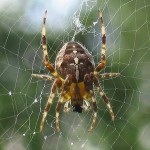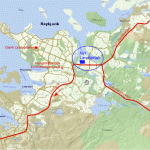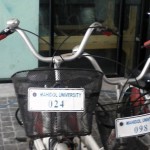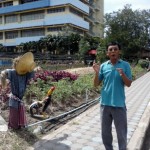I watched news on TV yesterday, about refugees and the awful things that happen every day now on our continent. Among other things, we were told that Iceland has agreed to receive no fewer than 25 refugees per year for the next two years!
The Minister of Social Affairs was, quite understandably, asked whether it wouldn't be possible for Iceland to accept a higher number of refugees. As politicians all too often do, she responded with a substantial number of words but completely dodged the question. She explained that those refugees that were picked out for coming to Iceland - mostly from groups that face severe discrimination elsewhere. That is all well and good - but was the minister implying that there are simply not much more people belonging to these groups, among the hundreds of thousands that now seek refuge in Europe? It really gets on my nerves when people in power get away with not answering important questions.
Icelanders as a whole have got away very lightly from shouldering their responsibilities as one of the richest nations on earth. The notorious Dublin Agreement for instance guarantees that by far most of those who ask for asylum here are swiftly chucked back to other European countries. This must change.
 They have arrived, on the outside of my house. The spiders. These remarkable animals appear with the summer and weave their artistic tapestries under the eaves of the roof, and sometimes outside the window, much to my delight. It is really interesting watching a skilled and determined European garden spider (Araneus diadematus) construct its web outside the window pane. Not to mention following a large group of tiny newly hatched spiderlings take their first arthropodean steps on the weatherboard. Nature is full of wonders, and one does not have to travel to the ends of the earth to appreciate it.
They have arrived, on the outside of my house. The spiders. These remarkable animals appear with the summer and weave their artistic tapestries under the eaves of the roof, and sometimes outside the window, much to my delight. It is really interesting watching a skilled and determined European garden spider (Araneus diadematus) construct its web outside the window pane. Not to mention following a large group of tiny newly hatched spiderlings take their first arthropodean steps on the weatherboard. Nature is full of wonders, and one does not have to travel to the ends of the earth to appreciate it.
Once I lived in Australia. That fair country has an excellent selection of spiders. I must admit that they were not all equally pleasing as neighbours. The redback spiders (Latrodectus hasseltii) resided in my garden shed. It was wise to keep them at a distance, as the bite of these antipodean arthropods is poisonous, small as they are. But the redback is one good looking spider for sure. On the other hand, some huge creatures of a very different kind sometimes took up position on my living room wall: the huntsman spiders (Holconia immanis). While they may not have been that pleasant to look at, they were quite nice once you got to know them. They did a good job of keeping the home free from various insects, also present in abundance Down Under.
But back to Iceland. I simply cannot fathom another regular feature of the summer in Reykjavík: Ads from some people who want to be allowed to poison those spiders of ours! These ads appear in the media soon after the spiders themselves. There is obviously a market for such things. But hang on... At the same time as Icelanders complain loudly of various bugs, such as wasps and now also biting midgesi, spiders are being poisoned - spiders that hurt nobody but flies! Perhaps those who keep the peddlers of poison in business have not thought things through fully?
In general, I dislike intensely the thought of houses and gardens being doused in poisonous stuff, whatever the reason might be. When spiders are considered, such deeds look like pure stupidity. Let's stop this poison business and enjoy summer life with the spiders.
Sorry, this entry is only available in Íslenska.

Arguments still rage about whether the airport in Vatnsmýri shall stay or go. Those who recently organised a petition for the airport to stay made much of its closeness to the National Hospital – whose location has also been disputed. I have had some difficulty in coming to a firm conclusion about these two issues, but now I think I have made up my mind.
I am convinced that it is not a good idea to build a new hospital in the same location as the old one, at Hringbraut. A better location would be further east at Ártúnshöfði, an area now occupied mainly by used car dealers and concrete mixing stations. The definite advantage is the good connections from there to transport routes and people (see map). The main road to the west passes by the site, and the main road south joins it not far away. For the large part of the country that is linked to the capital by land transport (including emergency transport by ambulance), this is a much better location than at Hringbraut. For the capital area itself, this also means better access to the hospital for more people. The centre of gravity of the population in the capital area is now in Fossvogur. This will not change overnight, even if planners in Reykjavík have now sensibly turned away from further suburbanisation and are working towards a more dense urban fabric west of Elliðaár. And there is (still) plenty of space up there. Activities like used car dealing and concrete mixing generally tend to move to the edges of urban areas. It is therefore only a matter of time before land use in this area starts to change, as has already happened in many former industrial areas in the city.
The idea is not without flaws, however. The existing hospital buildings at Hringbraut would not be of any use for the hospital of course. New uses would have to be found for them. Some importance has also been accorded to the closeness to the main campus of the University of Iceland, and the possibilities for creative collaboration due to this. I do not think this is crucial, when much daily contact takes place electronically. And the campus is well connected by bus to the Ártúnshöfði site.
And then the airport. I think that everybody would agree that the airport will not be there in Vatnsmýri forever. This is a great area for future urban development. That said, I am quite happy that some mad developers did not manage to get hold of this in the bubble years prior to the 2008 crash – we would have ended up with horribly ugly buildings of substandard quality. And I would not be unhappy if the airport stays for some more years. Meanwhile, we can learn more about how to plan and design a good urban environment. But eventually the aviation will be moved to Keflavík. Transportation is easy from there to the new hospital which will be built at Ártúnshöfði when the powers that be have accepted my geographical arguments.
In May this year I visited Mahidol University, located in the western suburbs of the Thai capital, Bangkok. My host there, dr. Sittipong Dilokwanich, works at the Faculty of Environment and Resource Studies, and was until recently the dean of the faculty. I was impressed by the progressive and original approach of this university when it comes to environmental issues. Among other things, studnets and staff can get bicycles for free use on the campus. When will that happen at the University of Iceland?

Bikes available for free use by students and staff at Mahidol University
Even more impressive was the fact that one corner of the campus has been set aside for growing vegetables. The land is rented out ot small farmers, who in turn supply staff and students with excellent veges at very reasonable prices, all grown using organic methods only. Perhaps this would be a little more difficult to do at the University of Iceland, but one could for example think about the 'horseshoe' - the little-used lawns right in front of the Main Building...?

Dr. Sittipong Dilokwanich at the organic university garden
In the new year, the cleaning team here in the Askja building was changed. This has happened regularly during the last years. You hear an incredible variety of languages spoken by the cleaners, who have, without exception, proved themselves to be really nice people when you get to know them a little. First these tasks were carried out by 'native' Icelanders, as well as Vietnamese who had emigrated to Iceland. Then we had a Polish team, followed by cleaning staff from Lithuania. I still haven‘t found out where the new cleaning team comes from. But these people are jovial and easy to have around, just like those who preceded them.
Of course this is one of the telltale signs of globalisation. Free flow of labour and all that stuff. But there is something in all this which I find disconcerting. Before, the cleaners were employees of the University itself. Then these tasks were outsourced in the name of financial savings. And we do not know how the contractors think. Could it be that people are regularly fired, before they get too uppity about their wages and conditions, in order to bring in new and docile labourers? I do not know. I do not know their wages – I would like to believe that wage agreements are being honoured, but I would not be surprised if the naked minimum wage rate is used. And the minimum wage in Iceland is just that – minimal.
The concept of "corporate social responsibility" is much brandied about nowadays by private firms and state institutions alike. I even recall hearing the top administration people at the University of Iceland utter those words. I wonder if this outsourcing of cleaning was part of increased social responsibility on part of the University? I do not know.
The Þingholt quarter in Reykjavík is built to a human scale, unlike some other parts of the city. The streets are old and narrow, cars move slowly and many people walk or bike. It is strange, however, that some streets, including the one where I live, Þingholtsstræti, some streetlights were erected at some point in time which would be appropriate for any motorway. Tall, grey things with lights that extend into the middle of the street above our heads. Outside my own house stands one such lamppost, even with a huge traffic sign so people cannot escape noticing it. Here the urban environment could, in a very simple way, be made more welcoming and warm for both inhabitants and guests, by designing different streetlamps. The design might for example make some references to the rich history of this part of town, but above all the motorway thingies should be removed. There is time for a new Enlightenment in 101 Reykjavík.
Once again the fisheries sector is at the centre of political debate in Iceland. And once again there seems to be more heat than light in the debate. A few days ago, a group of social scientists - myself included - sent a letter to the Prime Minister, asking for a thorough analysis of the social aspects of fisheries management to be undertaken. We think that these important matters have not been adequately addressed. The fisheries management debate takes place under the narrow terms set by economic analysis and legal technicalities. Given that the social questions are never far away whenever these issues are discussed, this narrowness is quite unfortunate. People do not have much research upon which to base their arguments. For example, what have been the real effects of the Individual Transferable Quota system on regional development? This is an important geographical question that has not been fully answered with research. Nor has existing research about fisheries by social scientists been brought into the discussion. We want to change that.

Last year I had a good discussion with two architecture students from Norway, Mathias Kempton and Gislunn Halfdanardottir. They were doing research for their final project for the Masters degree in Architecture at the Oslo School of Architecture and Design, about landscape, tourism and energy issues in Iceland, not least in the light (or shadow) of the recent Kárahnjúkar controversy. I found their thoughts about these issues very interesting. And now their project is finished: National Purist Routes: Industrial Expansion and Moving Icelandic Landscapes. In the report, they present numerous ideas about more progressive and diverse uses of Icelandic energy than was the case in the Kárahnjúkar power project. Energy stations at abandoned farms, communication with mussels, heated sunbathing spots at Þeistareykir og and a new Eden („drive-in Paradise“) in Hveragerði are some of the ideas discussed. Among other things, they question the ideology underwriting the recently completed Master Plan for Hydro and Geothermal Energy Resources in Iceland and think it might not be all that helpful to think about the world in discrete conceptual boxes like „human-made“ and „natural“. Really well executed and provocative piece of work.
Reykjavík, in the years prior to the economic crash of 2008, was a sorry mess of planning disasters. It is really painful to see such mistakes repeated in our wonderful post-crash times in a hellishly stupid proposal, about to be realised, in the town of Selfoss, South Iceland. This is a rather large shopping centre which some merry merchants are going to build to the west of Ölfusá, at the junction of Biskupstungnabraut and Suðurlandsvegur.
Why do I think this is a planning mistake? Because, for its inhabitants, it makes Selfoss a worse town than it could be. Planning theory nowadays advocates a dense urban fabric, such that people can access shops and service establishments without necessarily having to use a car. In a recent and very good Masters thesis by Hrafnhildur Brynjólfsdóttir at the University of Reykjavík, planning issues in Selfoss are thoroughly scrutinized. Many interesting things came out of her analysis.
I do care. For some two years I lived in Selfoss.





